Joint deployment of System Center 2012 (method and problems)

Apparently, to reduce the implementation time and simplify the test deployment of Microsoft System Center 2012, the Unified Installer tool for unified installation was created. In short, its essence is the deployment of all system components from a single window.
Below we will take a detailed look at the steps of the preparation and installation process, and also talk about those rakes that, as always, are waiting for us somewhere nearby. In general, the tool is really useful, with proper dexterity, you can manage to do everything in one working day.
Just in case, we recall the composition of the components included in System Center 2012, and their main functions:
- Virtual Machine Manager - virtual environment and cloud management (together with App Controller);
- Operation Manager - monitoring status and performance;
- Configuration Manager - OS and application deployment, data collection and inventory;
- Data Protection Manager - backup;
- Service Manager - management of IT services;
- Orchestrator is an automation system that links all components.
In the previous version, some components were missing and some were separate products. Accordingly, the implementation process for each of them was different. In the new version, the distribution package includes the Unified Installer installer image (hereinafter UI), the official information on which can be found here - http://technet.microsoft.com/library/hh751266.aspx . Since we at DEPO Computers often have to deploy SC products on test and combat stands, we decided to consider it in more detail.
Training
Our goal was to install Orchestrator, VMM, AppController, SCOM, and SCSM. SCCM and the backup system were previously installed in the standard way.
Deployment was intended in a virtual environment. A virtual machine template was created (2 cpu, 4gb memory, virtual disk 60gb), Windows 2008R2 EE was installed with all updates, WinRM and Remote Access Shell were configured (settings of local policies can be viewed at the above link, you can also configure them in the domain via group policy), based on the template 7 virtual machines were created:
- Srv1.test1.local - domain and DNS controller, configured first;
- Srv6.test1.local - Orchestrator, Unified Installer System;
- Tscvmm.test1.local - Virtual Machine Manager;
- Tscapp.test1.local - App Controller;
- Tscom.test1.local - Operation Manager;
- Tscsm.test1.local - Service Manager;
- Tscdw.test1.local (datawarehouse) - Service Manager.
You also need to download and unzip the entire System Center and from dozens of different distributions (links to them will be given in the 'Prerequisite Media Location' step, but note that they may lead you to a distribution with the wrong language).
A network folder \\ srv6 \ files was created on the Srv6 server, where all distributions were placed.
Before installation, we recommend just in case to make snapshots on all virtual machines. Naturally, except for the domain controller. The fact is that during the installation process an error may occur, and a snapshot will allow you not to create virtual machines again.
Customization
After running setup.exe from the UI distribution, the SC installation window will appear.

Please note that the installation can also be done in manual mode - to do this, click 'Custom install on local server'.
After starting the installation process, a warning appears, the essence of which is that if you already have the component deployed and you want to upgrade or reconfigure it, you should use Custom Install. Click OK.
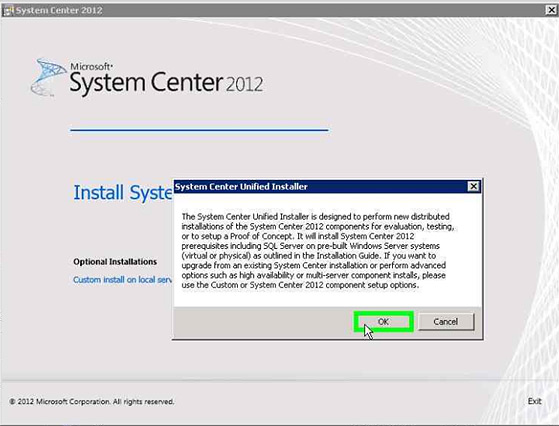
We do the installation without keys.

We select the necessary components. As mentioned above, we have already deployed Configuration Manager, and we do not need a backup system for the test bench.

We indicate the paths to the System Center 2012 distributions hosted on Srv6.

We confirm the license agreement.

We indicate all the paths to the distributions of related software. Pay attention to this step - here you can download the software from the links provided, put it in the necessary folders and continue.

Here's what it looks like on a file server.
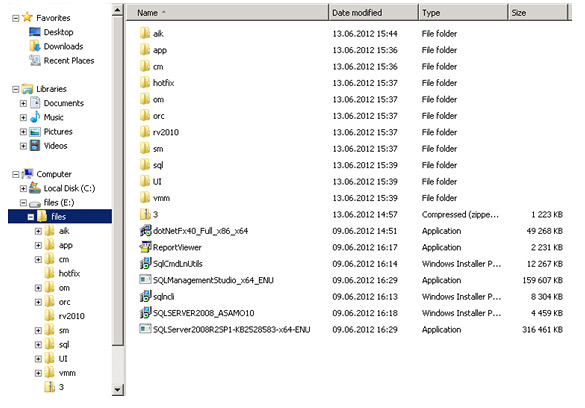
These settings can be left unchanged.
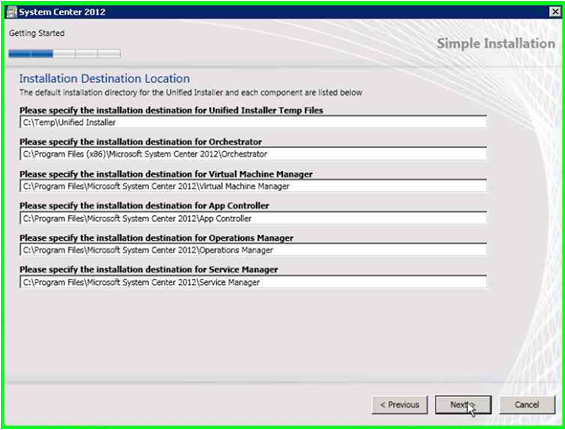
Specify the server names for each component. The UI does not allow you to install two components on the same server, but nothing prevents using Srv6, including installing one of the components. Service Manager requires two servers.
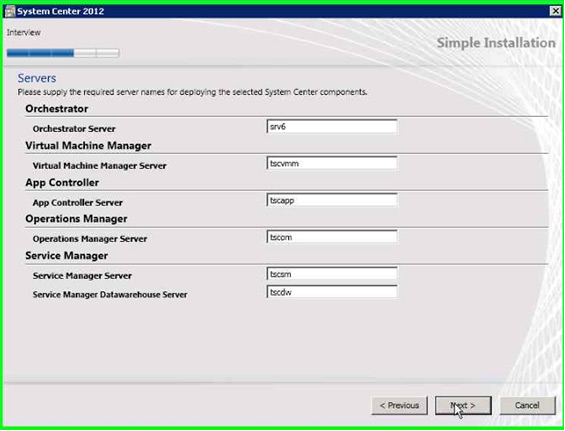
In this step, you must specify the account to deploy. It can also be used to launch services, which is convenient for test stands.

But when deployed in a production environment, you should still use separate accounts.
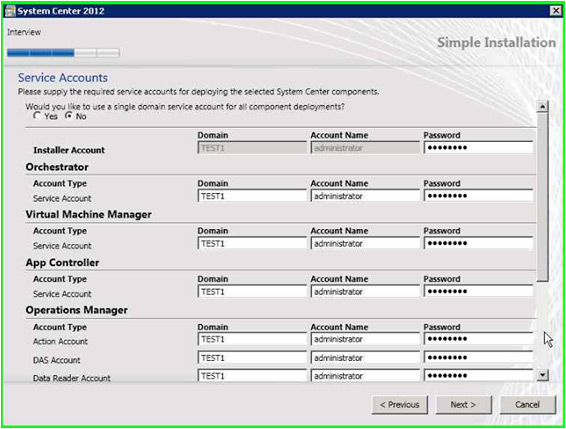

Setting up additional information.

Installation
The installation process is completely autonomous. Depending on the selected components, it can stretch for several hours, so think ahead of time how to pass the time.

As a result, the MSSQL 2008R2 server, its component, and the component base are installed on each server.
Management consoles
After installation, make sure that everything works.
App Controller:
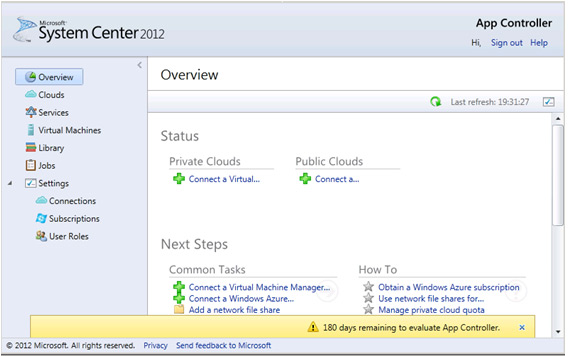
Operation Manager:

Orchestrator:
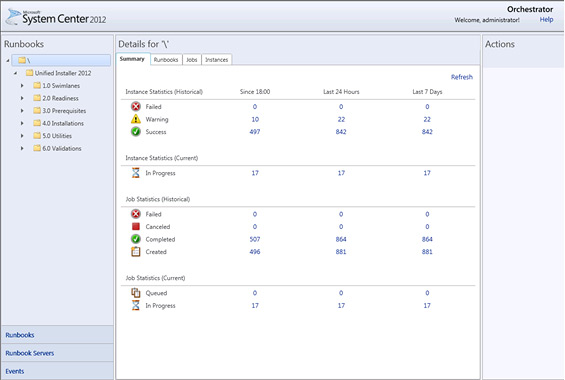
Virtual Machine Manager:
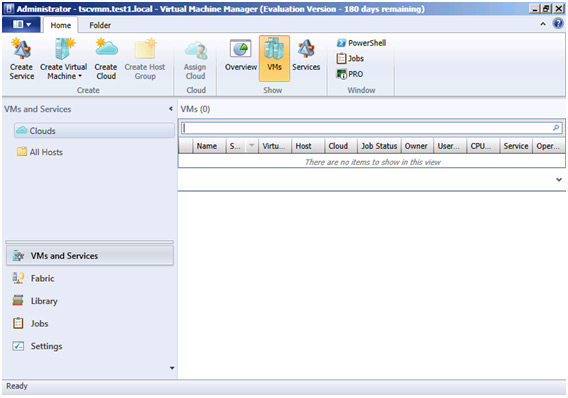
Service Manager:
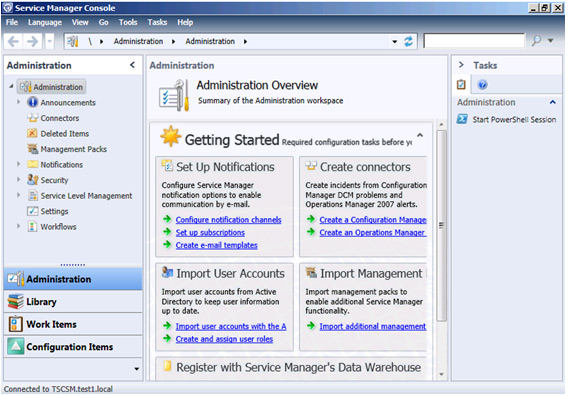
Server database location:

This can be considered a complete deployment. Further steps to configure each component can be found here: http://technet.microsoft.com/library/hh769199.aspx .
Remarks
It should be noted that although the distributions are located in a network folder, during the installation process they are copied to all servers on which the components are installed. That is why the volume of the system partition should be at least 60 GB.
The UI is designed so that it creates an MSSQL server on each virtual machine where the SC 2012 components are installed. Someone will find this inconvenient, in this case there is nothing left to do but use Custom Install with all the consequences.
UI does not allow to deploy SC 2012 on clusters. Which, however, is not a significant problem if you are already using a virtual environment with a Hyper-V or vSphere cluster. The virtual environment already provides high availability, if there are at least two servers with shared storage on which your virtual machines will be located.
If we compare the UI for SC 2012 with Topology Builder for MS Lync, it clearly does not reach a full-fledged deployment tool. For large distributed infrastructures with branches, Custom Install is required, and it is essentially the same as installing a specific component.
It can take a lot of time to download the numerous distributions required to install SC2012. It would be much easier if they were already included in the SC 2012 distribution, but alas.
PS SC 2012 is a large and complex product, and if anyone is interested in its other components, say - we will certainly write about them.
Vinchi ,
DEPO Computers
